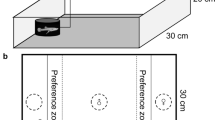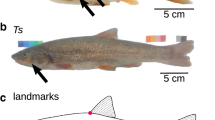Abstract
The preference for melanistic males was studied in two populations of eastern mosquitofish (Gambusia holbrooki, Pisces: Poeciliidae), one from Florida and one from northern Italy. Melanism in the eastern mosquitofish is a Y—linked character, expressed in males only. Melanistic males have black spots varying in size and number. In the Florida population, melanistic males are common, whereas in the Italian population they have never been observed. Females were male-deprived for at least 2 months before being tested in a dichotomous choice chamber. Italian females showed a significant preference for unpigmented males from their own population, whereas Florida females preferred melanistic males. When given the choice between males with few (<10% of the body surface) and males with many (>50%) black spots, Italian females preferred males with few black spots and Florida females those with many black spots. The preference of the Italian females for unpigmented males was confirmed in females reared from birth to maturity in the presence of only melanistic males. The preference of Florida females for melanistic males was also confirmed in females reared from birth to maturity in the presence of only unpigmented males. Altogether, these results demonstrate that in the eastern mosquitofish there is polymorphism in female preference and that this preference does not have an environmental basis.
Similar content being viewed by others
REFERENCES
Andersson, M. (1994). Sexual Selection, Princeton University Press, Princeton, NJ.
Angus, R. A. (1989). Inheritance of melanistic pigmentation in the eastern mosquitofish. J.Hered. 80:387-392.
Bakker, T. C. M. (1993). Positive genetic correlation between female preference and preferred male ornament in sticklebacks. Nature 363:255-257.
Bakker, T. C. M., and Pomiankowski, A. (1995). The genetic basis of female mate preferences. J.Evol.Biol. 8:129-171.
Bisazza, A., Vaccari, G., and Pilastro, A. (2000). Indirect female mate choice in a mating system dominated by male sexual coercion. Behav.Ecol. (in press).
Brooks, R. (1996). Melanin as a visual signal amplifier in male guppies. Naturwissenschaften 83:39-41.
Endler, J. A. (1980). Natural selection on color patterns in Poecilia reticulata. Evolution 36:76-91.
Endle r. J. A., and Houde, A. E. (1995). Geographic variation in female preferences for male traits in Poecilia reticulata. Evolution 49:456-468.
Farr, J. A. (1984). Premating behavior in the subgenus Limia (Pisces: Poeciliidae): Sexual selection and the evolution of courtship. Z.Tierpsychol. 65:152-165.
Gould, J. L., Elliott, S. L., Masters, C. M., and Mukerji, J. (1999). Female preference in a fish genus without female mate choice. Curr.Biol. 9:497-500.
Houde, A. E. (1994). Effect of artificial selection on male colour patterns on mating preference of female guppies. Proc.R.Soc.Lord.B 256:125-130.
Houde, A. E. (1997). Sex, Color, and Mate Choice in Guppies, Princeton University Press, Princeton, NJ.
Houde, A. E., and Endler, J. A. (1990). Correlated evolution of female mating preferences and male color patterns in the guppy Poecilia reticulata. Science 248:1405-1408.
Karplus, I., and Algom, D. (1996). Polymorphism and pair formation in the mosquitofish Gambusia holbrooki (Pisces: Poeciliidae). Environ.Biol.Fish. 45:169-176.
Liley, N. R. (1966). Ethological isolating mechanisms in four sympatric species of poeciliid fishes. Behaviour Suppl. 13:1-197.
Martin, R. G. (1977). Density dependent aggressive advantage in melanistic male mosquitofish Gambusia affinis holbrooki (Girard). Fla.Sci. 40:393-400.
Nelson, C. M., and Planes, K. (1993). Female choice of nonmelanistic males in laboratory populations of the mosquitofish Gambusia holbrooki. Copeia 1993:1143-1148.
Partridge, L. (1983). Non-random mating and offspring fitness. In Bateson, P. (ed.), Mate Choice, Cambridge University Press, Cambridge, pp. 227-255.
Pocklington, R., and Dill, L. M. (1995). Predation on females or males: Who pays for bright male traits? Anim.Behav. 49:1122-1124.
Regan, J. D. (1961). Melanism in the poeciliid fish, Gambusia affinis (Baird and Girard). Am.Mid.Nat. 65:139-143.
Stoner, G., and Breden, F. (1988). Phenotypic differentiation in female preference related to geographic variation in male predation risk in the Trinidad guppy (Poecilla reticulata). Behav.Ecol.Sociobiol. 22:285-292.
Taylor, S. A., Burt, E., Hammond, G., and Releya, K. (1996). Female mosquitofish (Gambusia affinis holbrooki) prefer normally pigmented males to melanistic males. J.Comp.Psychol.110:260-266.
Zulian, E., Bisazza, A., and Marin, G. (1995). Variations in male body size in natural populations of Gambusia holbrooki. Ethol.Ecol.Evol. 7:1-10.
Author information
Authors and Affiliations
Rights and permissions
About this article
Cite this article
Bisazza, A., Pilastro, A. Variation of Female Preference for Male Coloration in the Eastern Mosquitofish Gambusia holbrooki. Behav Genet 30, 207–212 (2000). https://doi.org/10.1023/A:1001914208075
Issue Date:
DOI: https://doi.org/10.1023/A:1001914208075




